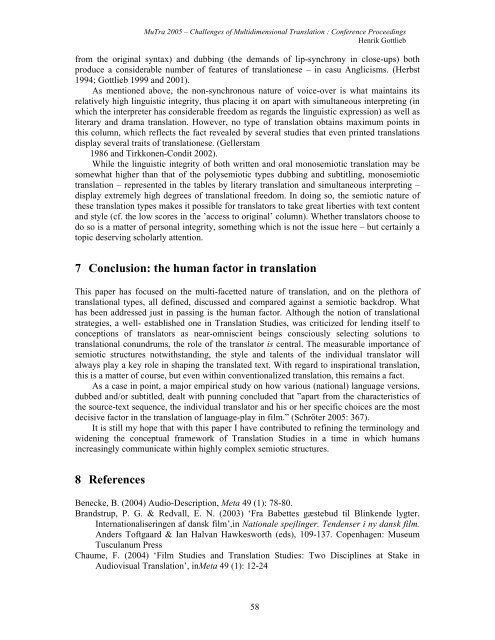Proceedings - Translation Concepts
Proceedings - Translation Concepts
Proceedings - Translation Concepts
You also want an ePaper? Increase the reach of your titles
YUMPU automatically turns print PDFs into web optimized ePapers that Google loves.
MuTra 2005 – Challenges of Multidimensional <strong>Translation</strong> : Conference <strong>Proceedings</strong><br />
Henrik Gottlieb<br />
from the original syntax) and dubbing (the demands of lip-synchrony in close-ups) both<br />
produce a considerable number of features of translationese – in casu Anglicisms. (Herbst<br />
1994; Gottlieb 1999 and 2001).<br />
As mentioned above, the non-synchronous nature of voice-over is what maintains its<br />
relatively high linguistic integrity, thus placing it on apart with simultaneous interpreting (in<br />
which the interpreter has considerable freedom as regards the linguistic expression) as well as<br />
literary and drama translation. However, no type of translation obtains maximum points in<br />
this column, which reflects the fact revealed by several studies that even printed translations<br />
display several traits of translationese. (Gellerstam<br />
1986 and Tirkkonen-Condit 2002).<br />
While the linguistic integrity of both written and oral monosemiotic translation may be<br />
somewhat higher than that of the polysemiotic types dubbing and subtitling, monosemiotic<br />
translation – represented in the tables by literary translation and simultaneous interpreting –<br />
display extremely high degrees of translational freedom. In doing so, the semiotic nature of<br />
these translation types makes it possible for translators to take great liberties with text content<br />
and style (cf. the low scores in the ’access to original’ column). Whether translators choose to<br />
do so is a matter of personal integrity, something which is not the issue here – but certainly a<br />
topic deserving scholarly attention.<br />
7 Conclusion: the human factor in translation<br />
This paper has focused on the multi-facetted nature of translation, and on the plethora of<br />
translational types, all defined, discussed and compared against a semiotic backdrop. What<br />
has been addressed just in passing is the human factor. Although the notion of translational<br />
strategies, a well- established one in <strong>Translation</strong> Studies, was criticized for lending itself to<br />
conceptions of translators as near-omniscient beings consciously selecting solutions to<br />
translational conundrums, the role of the translator is central. The measurable importance of<br />
semiotic structures notwithstanding, the style and talents of the individual translator will<br />
always play a key role in shaping the translated text. With regard to inspirational translation,<br />
this is a matter of course, but even within conventionalized translation, this remains a fact.<br />
As a case in point, a major empirical study on how various (national) language versions,<br />
dubbed and/or subtitled, dealt with punning concluded that ”apart from the characteristics of<br />
the source-text sequence, the individual translator and his or her specific choices are the most<br />
decisive factor in the translation of language-play in film.” (Schröter 2005: 367).<br />
It is still my hope that with this paper I have contributed to refining the terminology and<br />
widening the conceptual framework of <strong>Translation</strong> Studies in a time in which humans<br />
increasingly communicate within highly complex semiotic structures.<br />
8 References<br />
Benecke, B. (2004) Audio-Description, Meta 49 (1): 78-80.<br />
Brandstrup, P. G. & Redvall, E. N. (2003) ‘Fra Babettes gæstebud til Blinkende lygter.<br />
Internationaliseringen af dansk film’,in Nationale spejlinger. Tendenser i ny dansk film.<br />
Anders Toftgaard & Ian Halvan Hawkesworth (eds), 109-137. Copenhagen: Museum<br />
Tusculanum Press<br />
Chaume, F. (2004) ‘Film Studies and <strong>Translation</strong> Studies: Two Disciplines at Stake in<br />
Audiovisual <strong>Translation</strong>’, inMeta 49 (1): 12-24<br />
58
















